We love cows.
We love cows so much, they're often the first things we think about each morning. Through rain, sleet, snow, and hail it's our job to ensure they're living their best lives.
Just like you, we care about how the beef we purchase at the grocery story, or in a restaurant, is raised and harvested. For the sake of full transparency, we're outlining a few questions we receive on a regular basis. If you have a question not answered below, let us know.
Are there antibiotics in the beef I purchase at the grocery story?
Whether the label says “no antibiotics” or not, the meat or milk you buy is free of harmful residues from antibiotics¹.
Are there hormones in my beef?
All living things, like humans, have naturally occurring hormones. Let's compare the estrogenic activity of common foods (ng per 3 oz serving or 85 g serving)².
- Soy flour: 128,423,201
- Tofu: 19,306,004
- Kidney Beans: 153,087
- White Bread: 51,029
- Chicken³: 1.8
- Eggs: 94
- Beef⁴ : 1.9 (implanted); 1.3 (non-implanted)
- Milk: 5.4
What does "quality" mean for a cattle farmer?
To us, quality refers to the entire process of raising beef. Quality means we feel proud of our animal husbandry practices and the way our beef tastes. We thoroughly enjoy eating our beef and we know you will, too. When our kids ask, “are we having beef for dinner? Because that’s the best food.” That’s quality.
How do you care for your cattle?
It’s our responsibility to raise healthy animals.
We do this by keeping our livestock safe, comfortable, and healthy through each stage of life. On our family-owned and operated farm, we employ the methods and techniques our management system, and we take steps to verify their compliance.
Keeping the well-being of our livestock as our main priority not only keeps their quality of life high; it also makes our business more competitive.
How do you, as farmers, care for the land?
Our livelihoods are tied to the land, and because of this we go to great lengths to protect and improve our pastureland.
To provide consistent, clean water sources for our animals, we fence cattle out of ponds and allow livestock access to the pond from a planned point of access. This protects the pond from erosion, nutrient and algae build-up, and among other issues.
Are there guidelines for antibiotics use in cattle?
The Beef Quality Assurance (BQA) program has been in place since the 1980’s. BQA is a nationally-coordinated, voluntary program that includes guidelines for cattle farmers and ranchers and includes 14 guidelines for use of antibiotics.
Recent guidance by the FDA (209 and 213) requires more veterinary oversight for use of antibiotics that are important in human medicine. It also phases out the use of antibiotics for growth purposes⁵.
With these changes in regulations, the BQA program has developed “Antibiotic Stewardship For Beef Producers,” a convenient resource for cattlemen to make sure they have the latest information on antibiotic use.
Do you have to use antibiotics to treat cattle?
Antibiotics are just one tool that can be used by cattle farmers to ensure the health of the animals in their care. Cattlemen work closely with veterinarians when a herd or a member of the herd becomes ill or at times when cattle are susceptible to illness, using precise doses of an antibiotics to prevent specific diseases or conditions. However, sometimes an animal becomes sick and not treating a sick animal would be cruel. Cattlemen work closely with veterinarians when a herd or a member of the herd becomes ill or at times when cattle are susceptible to illness, using precise doses of an antibiotic to prevent specific diseases or conditions.
The short answer to this question is, yes. There are currently ten total crops grown from genetically modified seeds approved for use in the U.S.: corn, soybeans, cotton, canola, alfalfa, sugar beets, papaya, potatoes, apples and squash⁶.
Feeding of these crops (corn, soybeans, alfalfa) is common in raising cattle, and others more commonly fed in the form a byproduct from the processing for human use (cotton, canola, sugar beets, potatoes, and apples). Cattle feed made from these crops, grown from conventional or genetically modified seed may be used safely.
The primary reason GMO seeds are used in growing cattle feed are the benefits of reducing the need for herbicides, insecticides, and fertilizers while maintaining crop yields. This allows farmers to grow feed for livestock and food for people using less land, water, and field applications.
What does the label really mean?
Like the farmers and ranchers who choose how best to raise their cattle for beef, you have choices when it comes to the beef you buy. Cattle are raised responsibly and beef is safe, wholesome and nutritious – but you may see a variety of statements that reflect different production practices on beef packages in your grocery store or on a menu. The U.S. Department of Agriculture (USDA) approves these labels for beef based on specific criteria.
Grain Finished
Grain-finished beef comes from cattle that:
- Spend the majority of their lives eating grass or forage.
- Spend 4-6 months at a feed yard eating a balanced diet of grains, local feed ingredients, like potato hulls or sugar beets, and hay or forage.
- May or may not be given U.S. Food and Drug Administration (FDA)-approved antibiotics to treat, prevent or control disease and/or growth-promoting hormones
(most beef is raised this way and likely doesn’t have a specific label claim)
GRASS-FINISHED OR GRASS-FED
Grass-finished or grass-feed beef comes from cattle that:
- Spend their whole lives eating grass or forage
- May also eat grass, forage, hay or silage at a feedyard
- May or may not be given FDA-approved antibiotics to treat, prevent or control disease and/or growth-promoting hormones
CERTIFIED ORGANIC
Certified organic beef comes from cattle that:
- Never receive any antibiotics or growth-promoting hormones
- May be either grain-or grass-finished, as long as the USDA’s Agriculture Marketing Service (AMS) certifies the feed is 100% organically grown
- May spend time at a feed yard
Naturally Raised
Naturally-raised beef comes from cattle that:
- Never receive any antibiotics or growth-promoting hormones
- May be either grain- or grass-finished
- May spend time at a feed yard
Sources
¹ http://fda.gov/downloads/forconsumers/consumerupdates/ucm421483.pdf
² Units are nanograms of estrodoil for animal products and isoflavins for plant products per 3 oz serving of food
³ http://www.thepoultrysite.com/articles/2812/chickens-do-not-receive-groth-hormones-so-why-all-the-confusion/
⁴ http://newsroom.unl.edu/announce/beef/2846/15997
⁵ Guidance for Industry #209, Source: FDA 2012; Guidance for Industry #213, Source: FDA 2013
⁶https://www.ers.usda.gov/webdocs/publications/45179/43668_err162.pdf?v=41690










